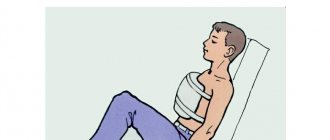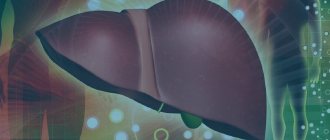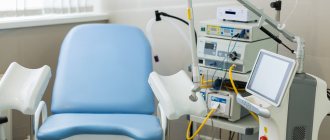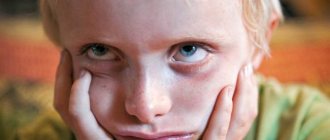Agoraphobia is a neurotic mental disorder, manifested by a fear of open space, squares and streets, where a large number of people with unpredictable demands and reactions could potentially appear or are already present. This phobia is a protective mechanism of the psyche in response to previously received psychological trauma associated with people. Belongs to the group of obsessive-compulsive neurotic disorders, that is, neuroses characterized by obsessive fear and the possible formation of “protective” obsessive rituals (actions). The intensity of agoraphobia can vary, but in any case it involves avoidance of the source of the perceived fear. Depending on the intensity of its manifestations, a phobic disorder based on the fear of open space and crowds is the most maladaptive among all other types of phobias.
Description
Agoraphobia is a borderline mental disorder belonging to the class of neurotic obsessive fears.
It is characterized by a fear of large crowds of people, crossing squares and wide streets, as well as situations in which there is no possibility of remaining unnoticed by others. Develops on the basis of traumatic situations associated with the need for personal or social contact. The term “agoraphobia” comes from the ancient Greek language, in which the word “agora” means “market, bazaar, place of interaction between people.” This disorder occurs as a result of emotional shocks and can be primary (independent) or secondary, developing on the basis of other mental disorders such as panic attacks, post-traumatic stress disorder, depression and schizophrenia. The general ICD-10 code is F40.0. In this case, agoraphobia without panic disorder is designated by the code F40.00, and with panic disorder – F40.01.
The prevalence of agoraphobia ranges from 0.5 to 7% in different countries, which is likely due to diagnostic characteristics. The typical age of debut is from 15 to 25 years. Among other phobic disorders, this is a rather late onset (most simple fears arise in childhood, and social fears in adolescence). The first symptoms appear suddenly in a situation of social contact, for example, on public transport or in a store. The disease is characterized by a chronic course with remissions and exacerbations.
The pathogenesis of agoraphobia is based on a conditioned reflex mechanism: having once experienced a negative experience, the human psyche quickly “learns” to react to similar situations with avoidance, namely a feeling of fear. The main difference from the normal reaction is that the nature of the fearful stimulus and its strength do not correspond to the intensity of the fear. The reasons for the development of agoraphobia include:
- Biological factors. These include features of the nervous system such as increased excitability and instability. In other words, phobias are more often formed in people with a melancholic type of temperament. Recently, a connection was discovered between the incidence of agoraphobia and difficulties in spatial orientation: the risk of the disease is higher with poor development of the vestibular system, when a person relies more on visual stimuli. With such features, disorientation in the area often occurs, which provokes discomfort and fear.
- Hereditary predisposition. Agoraphobia most often occurs in people whose close relatives have phobias, depression, anxiety disorders, and panic attacks. There are certain genetic factors that affect the biochemical processes of the brain, in particular the activity of neurotransmitters responsible for the emotional state.
- Accompanying illnesses. At risk are people with panic disorder, other phobias (for example, fear of communication), neurological and endocrine diseases that affect a person’s mental state.
- External adverse influences. Agoraphobia can be triggered by a fight, an act of violence, an accident, a terrorist attack, a divorce from a spouse, the death of a loved one - any situation that causes fear or panic. In addition, the risks increase when taking drugs and alcohol.
Reasons for appearance
Experts cannot name the main “culprit” for the development of agoraphobia. It is believed that the root cause is a panic attack, which turns into an anxiety disorder. Others believe the diametrically opposite: first a fear of open spaces appears, and panic attacks “follow” from it. A compromise between these theories has not yet been achieved, but one thing is clear - these pathologies are very closely related.
Sigmund Freud's concept
The founder of psychoanalysis proposed his concept of the development of agoraphobia and other anxiety disorders: since they are all neurotic pathologies (neuroses), their origin is at the psychogenic level.
Freud believed that the main symptom of the disease, anxiety, is the result of an intrapersonal conflict that arose in childhood or adolescence, a compromise between the drive (“it”) and the prohibition on this desired (“superego”). This, in turn, transforms into sensations such as tremor, shortness of breath, and suffocation.
Academician Pavlov's theory
The great physiologist considered any fear to be a conditioned reflex. That is, if some incident occurs to an individual or a person close to him, causing fear, then when he finds himself in such a situation, the brain begins to “sound the alarm.” Over time, growing like a snowball, such fear transforms into agoraphobia. But one can argue with this: not all people who have experienced trouble in a crowd get sick, and on the contrary, the disorder develops in those who have not had such cases.
Is the vestibular apparatus to blame for everything?
Not so long ago, research results appeared claiming that it is problems with the vestibular apparatus that are responsible for agoraphobia. It is located in the inner ear, in the bony labyrinth, and its functional duty is to orient the movement of the human head and body. That is, the signals from the visual-muscular system and the vestibular apparatus must be balanced. However, problems with the latter do not allow agoraphobes to normally perceive tactile sensations from a surface and visually clearly see objects. This disorientation leads to agitation and a panic attack.
Symptoms
Photo: hygienepath.com
Agoraphobia is characterized by fear and anxiety that manifests itself in situations with open spaces, large crowds of people and/or the need for spontaneous interaction with people. The symptom may appear in line at the supermarket checkout, when leaving a cinema, on public transport and in other similar places. At first, the phobia occurs only in a specific situation, but gradually the number of triggers increases. Thus, fear may first appear on an airplane, and then spread to all types of transport. In severe cases, people stop leaving the house.
Phobia can be associated with two aspects. The first is fear of public condemnation or shame. The second is the fear of losing control over the environment. In the first case, the presence of strangers plays a decisive role, namely the likelihood of their negative assessment. A person with agoraphobia is afraid of being helpless, incompetent, and funny. The fear of having a panic attack in front of others increases the likelihood of having a panic attack. The second type of agoraphobia is often manifested by the fear of freezing, suffocating, overheating, or being attacked. With this option, a person feels calm in a familiar space, even if there are a lot of strangers there.
Subjective symptoms experienced by people with agoraphobia:
- feeling of isolation;
- panic attacks;
- derealization (feeling of unreality of what is happening);
- depersonalization (feeling alienated from one’s own personality);
- cardiopalmus;
- increased sweating;
- trembling in the arms and legs, throughout the body;
- dizziness;
- feeling of lack of air.
With a long course of agoraphobia, patients develop avoidance behavior, anticipation of anxiety, depression, and hypochondria. This leads to frequent medical examinations, hospitalizations with unidentified diagnoses, disruption of family relationships, and decreased ability to work. Dependence on drugs and alcohol often develops.
Consequences of agoraphobia
Having experienced a panic attack, an agoraphobe begins to avoid visiting places where it can develop again. He develops an unhealthy fear of long trips, crowded places, and public transport. Gradually the situation worsens, the agoraphobe begins to be afraid to leave the confines of his home and go outside. As a result, the problem can get very worse, leading to job loss and the inability to lead a socialized life.
In approximately half of the cases, there is no improvement in the condition, and the disease leads to disability. Seventy percent of such patients develop depression.
Diagnostics
Photo: pediatrinfo.ru
If there are signs of agoraphobia, you should consult a psychiatrist who will conduct a clinical examination and confirm or deny the presence of the disease. Diagnosis is carried out by conversation, observation and history taking. Agoraphobia is defined if all the criteria recommended by ICD-10 are present:
- vegetative and psychological symptoms of phobia are the primary expression of anxiety, and not the secondary manifestation of delusions and obsessive thoughts;
- anxiety is a consequence of at least two of the proposed situations: the presence of a crowd of people, being in a public place, moving outside the home, traveling alone;
- a pronounced symptom is avoidance of situations that cause fear and discomfort.
Sometimes psychiatrists additionally use the criteria proposed by DSM-5 (fifth edition of the Diagnostic and Statistical Manual of Mental Disorders). According to this document, with agoraphobia, fear or anxiety in relation to 2 or more of the following situations must be observed for 6 months or longer:
- being on public transport;
- being in open space (squares, parking lots);
- being in a closed space (shop, cinema hall);
- staying in line;
- moving alone outside the home.
Most patients complain of anxious thoughts about deteriorating health or about a hopeless situation in which no one will help them. They are afraid of attacks of fear and panic, avoid frightening situations, and need to be accompanied by friends or relatives. Their anxiety is not proportional to the actual threat, and avoidance behavior leads to significant discomfort and disruption of socialization.
How to get rid of agoraphobia
The use of drug therapy alone to treat fear of open space is unpromising, although in the initial stages, the doctor may prescribe sedatives (calming agents) and certain antidepressants to alleviate the condition. They help reduce overall anxiety levels. But if you limit yourself to only this method of treatment, soon after stopping the drugs, attacks of fear will resume with the same force, which is explained by the preservation of the internal mechanisms of phobia formation. It is possible to free yourself from fear with the help of psychotherapy.
Treatment of agoraphobia may require the use of several psychotherapeutic techniques. A competent and experienced doctor combines them, helping to control panic attacks and gradually eliminating the cause of anxiety. Specialists use exactly this approach and individually select a psychotherapy regimen.
The treatment of agoraphobia is usually based on rational and cognitive-behavioral psychotherapy, supplemented by various relaxation techniques. A person with a fear of open space is taught controlled breathing, special exercises to relax the body, auto-training and visualization. In some cases, the doctor uses classical or Ericksonian hypnosis to quickly reduce the severity of panic attacks. And long-term therapy can be supplemented with psychoanalysis and other psychotherapeutic techniques.
To make an appointment with a psychotherapeutic specialist, you can use a special form or contact the administrator yourself using the phone numbers provided at the top of the page.
Treatment
Photo: zen.yandex.ru
Treatment for agoraphobia is determined by the nature of the disorder, its duration and the severity of symptoms. If the disease proceeds without panic attacks, then minimal drug intervention and emphasis on psychotherapy are indicated. Patients are prescribed short-term use of tranquilizers during periods of exacerbation, as well as sessions of behavioral and cognitive therapy.
For agoraphobia with panic attacks, the use of benzodiazepine anxiolytics, as well as antidepressants from the group of selective serotonin reuptake inhibitors (SSRIs), is indicated. The duration of medication and their combination is selected by the doctor individually. Among the psychotherapeutic approaches the most effective are:
- Cognitive-behavioral direction. Patients are taught to recognize and control distorted thoughts, false beliefs, and resulting emotions and behavior.
- Exposure therapy. Its essence lies in the fact that the patient is immersed in an imaginary frightening situation, and then taught methods of relaxation and self-control. In the future, imaginary situations are replaced by real ones.
- Inversion methods. During the discussions, patients' belief that they are able to control anxiety and prevent panic attacks through willpower is challenged. As a result, such attempts stop, internal tension in trigger situations decreases, and the phobia becomes less pronounced.
Forecast
With agoraphobia without panic attacks, the prognosis is favorable: patients almost cease to avoid trigger situations and remain adapted to life in society for many years. In other words, they manage to stay in remission for a long time. With frequent panic attacks and poor effectiveness of drug therapy, the prognosis is less favorable: patients lose their ability to work, many do not leave the house.
The information is for reference only and is not a guide to action. Do not self-medicate. At the first symptoms of the disease, consult a doctor.
Agoraphobia in Russian psychiatry was predominantly considered within the framework of obsessive-compulsive neurosis (5,11). However, at present, taking into account international experience and the spread of new classifications of mental disorders, the tendency towards nosographic differentiation of obsessions is becoming more and more definite.
Thus, panic and obsessive-compulsive disorders, simple phobias, and social phobias were identified. A relationship has been established between phobic conditions, affective, somatoform disorders, as well as behavioral syndromes associated with physiological disorders (2,14).
In the context of these changes, the qualification of agoraphobia as an independent disorder that unites previously distinct cases of obsessive fears of open and closed spaces seems justified (9, 19).
In recent decades, diagnostic criteria for agoraphobia have been developed, on the basis of which a series of studies have been conducted on the prevalence and comorbidity of this disorder (17,21). Nevertheless, a number of aspects of the agoraphobia clinic remain open. Among them is the question of the syndromic structure of this disorder, its dynamics, as well as the personal characteristics of these patients.
This report summarizes the data from a study of a group of patients with agoraphobia syndrome (68 people). Selection into it was made according to ICD-10 criteria and was based on the patient’s statement of unreasonable fear that arises in crowds, public places, situations associated with being or moving alone, or moving outside the home. To qualify the syndrome, it was also necessary to establish the patient’s tendency to avoid these situations and maintain a critical attitude towards existing disorders.
The majority of the group were women (54 people). The age of patients ranged from 17 to 64 years (average 35 years). 48 of them were married, 20 were single, including 5 divorced. Despite the high educational level (30 patients had higher and 38 incomplete higher or secondary education), only 18 patients worked, and 19 were only part-time employed. The diagnosis of agoraphobia was the main one in 59 cases. In 11 patients, this diagnosis was established as an additional diagnosis against the background of recurrent depressive disorder (5 people), bipolar affective disorder (3 people), a single affective episode (2 people) and organic brain damage (1 person). Agoraphobia in schizophrenia was not included in the study. In 59 patients the condition was classified as agoraphobia with panic disorder, and in 9 as agoraphobia without panic disorder. The duration of the disease in all examined patients was at least 1 year (from 1 to 3 years - 36 people, from 4 to 10 years - 24 people, more than 10 years - 8 people). All patients had previously consulted specialists for existing disorders, 35 of them were hospitalized in psychiatric hospitals, 13 more than once.
A psychopathological analysis of the condition of the examined patients showed that the clinical manifestations of agoraphobia are very polymorphic and dynamic. At the same time, symptoms corresponding to the operational criteria of ICD-10 are necessary, but not sufficient for a detailed clinical description of this disorder. For this purpose, it is advisable to supplement the operational approach by considering the entire set of disorders identified in patients with agoraphobia in the structure of the major psychopathological syndrome (10). This makes it possible to study the clinical picture of agoraphobia both statically and dynamically, as well as to evaluate the characteristics of the soil in which the disorder arose.
As the study of the condition of patients shows, the psychopathological structure of agoraphobia in static conditions has basic and additional components. The main ones include agoraphobic disorders, somatoform symptoms, and affective disorders. Additional ones include other anxiety disorders and drive disorders. The agoraphobic symptom complex itself includes situationally determined anxiety-vegetative paroxysms and the so-called phobic avoidance (20). Anxiety-vegetative attacks in the examined patients occurred in situations, the common feature of which was the presence of spatial barriers (distance, partitions, obstacles, etc.). The fear that arises during these attacks was specific in nature and was usually associated by patients with a feeling of impending death or madness. It is important that it was preceded by a feeling of helplessness that gripped patients in a phobic situation. Depersonalization-derealization episodes and psychomotor agitation were often observed. This picture was complemented by protruding and polymorphic vegetative disorders in the form of palpitations, sweating, tremor, shortness of breath, vasomotor reactions, etc.
In their most extensive form, anxiety-vegetative paroxysms were observed in the variant of agoraphobia with panic disorder. Their peculiarity, in our opinion, was the absence or insignificant severity of intrapunitive experiences (embarrassment, shame, guilt), which usually accompany paroxysms of fear in “pure” panic disorder, as well as their comparatively lower overall intensity. In the variant of agoraphobia without panic disorder, no extensive anxiety-vegetative paroxysms were observed. However, in many cases, these patients also experienced low-symptomatic paroxysmal vegetative changes, accompanied by emotional tension or episodes of asthenia.
Phobic avoidance is another important manifestation of the agoraphobic symptom complex. This symptom is its objective behavioral characteristic, which largely determines the severity of the patient’s condition. It lies in the tendency of these individuals to avoid contact with a situation that frightens them, not to talk about it or remember it. As observations showed, as a result of the difficulties that arose among the studied patients with going out into the street, traveling in transport, and the need to remain alone, a significant part of them (42 people) were seriously disabled. They found themselves unable to fulfill family and professional responsibilities, and their contact with others was significantly limited. At the same time, the severity of avoidance did not depend on the intensity of anxiety-vegetative paroxysms, but was determined by the feeling of inability to perform the necessary actions or receive adequate help if health deteriorated.
Somatoform symptoms occupy a significant place in the structure of agoraphobic states. The studied patients consistently (91%) complained of a variety of bodily sensations, often arising or intensifying during anxiety-vegetative paroxysms. Among them, algias predominated, and sometimes baric or thermal sensations. In most cases, sensations were limited in duration and localization and were not subject to conceptual processing. However, in approximately 30% of patients, somatophoric symptoms were more stable, bodily sensations acquired a generalized nature, senestopathy and hypochondriacal tendencies. In such observations, we were talking about a combination of agoraphobia with various types of somatoform disorders.
With a high frequency (74%), patients with agoraphobia had affective disorders corresponding to mixed anxiety and depressive disorder (27 people), as well as mild or moderate affective episodes (23 people) according to ICD-10. In 39 cases, these conditions were classified as secondary depression, since they arose in connection with agoraphobic symptoms, occupied a subordinate position in the clinical picture and were determined by situational factors. However, along with this, the described patients also had primary depression (6 people), erased episodes of mixed states (3 people) and hypomania (2 people).
Along with the named main components of the major agoraphobic syndrome, a number of patients had additional psychopathological manifestations: specific phobias (18 people), social phobias (9 people), generalized anxiety (10 people), alcoholism (13 people), bulimia (6 people .) etc. These disorders, not being obligate components of the syndrome, are nevertheless often combined with agoraphobia (17). Clinically, the features of the course of agoraphobia are of significant importance. Observations show that in the overwhelming majority of cases, the manifestation of the disease is associated by the patients themselves with anxiety-vegetative paroxysms, which are usually accompanied by phobias for a short time. However, an in-depth analysis of anamnestic data allows us to establish that in the premorbid period of patients, subclinical affective fluctuations, abnormal personality reactions, or behavioral disorders were often noted. They usually preceded the occurrence of anxiety-vegetative paroxysms and were accompanied by a sharpening of personality traits, adaptation disorders, and antisocial manifestations. As a rule, there were protracted stressful situations associated with family conflicts, migration, difficulties in personal life or at work. A very typical situation was the “social mousetrap”, in which patients had to significantly change their life pattern in order to achieve a certain social stability and security.
The key thing for patients in such situations was the difficult-to-tolerate subjective feeling of complete dependence on external circumstances and the associated difficulties in maintaining their identity. It should be especially emphasized that in approximately a quarter of observations, agoraphobic states developed against the background of cessation of alcohol abuse or as part of bulimia nervosa.
As for the dynamics of agoraphobic symptoms themselves, in accordance with the identified (1) types of course in the examined patients, in 72% one could speak of a continuous course, and in 28% of a recurrent course of agoraphobia. A recurrent course was observed when agoraphobia occurred against the background of recurrent and bipolar affective disorder. At the same time, this type of course might not be combined with mood disorders. Intermissions in these cases were usually due to the therapy being carried out or a change in the microsocial situation.
With a continuous type of course, the clinical picture was more complex. Secondary depression, concomitant somatoform disorders, as well as the above-mentioned additional psychopathological manifestations were consistently observed. This variant of the course usually developed in conditions of chronic psychogenicity in patients with severe personality anomalies. However, even here, with adequate treatment, including psychotherapy, or a favorable change in the situation, the patients’ condition could significantly improve.
The emergence of abnormal personal reactions in premorbid patients, the nature of the dynamics of agoraphobia, the role of psychogenics, as well as the reflection of key experiences in the clinical picture indicate the need to assess their personal characteristics. The results of the examination of these patients indicate a significant frequency of personality anomalies. The latter in 36 patients met the ICD-10 criteria for personality disorders, i.e. they were found in several mental areas, were stable, deep, formed at an early age, manifested themselves in a wide range of situations and caused disturbances in social adaptation already in premorbidity. In 32 patients, personality anomalies were classified as stable accentuations of character (6,7), since they were not deep and did not significantly affect the general level of social adaptation of the patients.
Depending on the characterological type, patients with personality disorders and accentuations, respectively, were distributed as follows: emotionally unstable (44%) - 21 and 9 people, evaders (19%) - 5 and 8 people, anancastic (18%) - 3 and 9 people, histrionic (8%) - 2 and 6 people, dependent (7%) - 5 people. (personality disorder only). When considering these data, it should be emphasized that they are in good agreement with the opinion of Hoffart (16) about the connection of agoraphobia with those types of personality deviations that are included in the classes of dramatic and anxious according to DSM-III-R. That is, in some patients (emotionally unstable, histrionic) expansive forms of response predominated, combined with insufficient controllability of behavior, demonstrativeness, affective lability and instability of preferences. For others (evaders, anankastes, dependents), self-limiting tendencies with hypertrophied self-control, excessive caution, adherence to social stereotypes and avoidance of responsibility came first. It is important to note that the same patient could have both of these tendencies, and only the comparative predominance of one of them determined the clinical personality type.
Along with the pathocharacterological features, when examining patients with agoraphobia, attention was drawn to other manifestations of personality anomalies, which, in our opinion, are of paramount importance for the clinic of agoraphobia. This includes a wide and relatively little-studied range of deviations associated with impaired cognitive processes, described in psychopaths as the phenomenon of partial uncriticality (3,12). These anomalies consist in the peculiarities of perception and interpretation of events, the formation of motives and relationships, changes in self-awareness and self-esteem. These changes in the examined patients were manifested by an affectively determined distortion of thinking, which was most clearly expressed in their inherent catastrophism. This feature is pointed out by a number of authors (15, 18). It is most clearly revealed in moments of contact with a phobic situation, when patients begin to interpret the slightest changes in their condition or environment in an unfavorable and threatening sense.
However, catastrophism in the examined patients was also found in behavior that was not related to phobic situations. It manifested itself in a tendency to “self-intimidation,” “self-restraint,” and exaggeration of life’s difficulties. The noted features were combined with so-called “black and white thinking,” as well as difficulties in understanding and expressing experienced feelings and drives. Moreover, the greatest difficulties for patients with agoraphobia arose in situations related to awareness and open manifestation of expansiveness. Taking into account the above, there is no doubt that here we are talking about the stylistic features of the organization of cognitive processes that characterize the personality.
Thus, the study indicates that agoraphobia is characterized by a complex and dynamic psychopathological structure, in which phobic symptoms themselves do not occur in isolation, but are combined with a wide range of somatoform, affective and other anxiety disorders. In addition, in patients of this category, personality anomalies are constantly revealed, which are formed in the premorbid period and contribute to various kinds of reactions and behavioral disorders. All these features, according to ideas expressed in recent years by a number of authors (13, 22), can be regarded as manifestations of mental diathesis, an important property of which is increased sensitivity to psychogenies. It should be noted here that, in accordance with the views coming from Morel and Kraepelin about the emotional conditioning of phobias, their genesis was associated with congenital premorbidity, characterized by the traits of anxious suspiciousness, inhibition, sensitivity and asthenia (11). However, since it was later shown that phobias in general and agoraphobia in particular can be formed in individuals of various types (5,8), the question of the role of soil to a certain extent has lost its former relevance.
The results of our research indicate that a different approach is possible in this matter. As the author of the doctrine of psychasthenia, P. Janet, pointed out (4), in this condition, first of all, the intellectual processes responsible for assessing and experiencing direct contact of the “I” with reality suffer. Therefore, when considering the characteristics of a premorbid, his emotional characteristics in themselves are not of decisive importance. An analysis of clinical manifestations and personality anomalies in patients with agoraphobia leads to the conclusion that the leading role here is played by premorbid disorders in the sphere of behavioral control associated with the coordination of oppositely directed (expansive and self-limiting) impulses. Since this coordination is carried out by the cognitive apparatus and is mediated by the self-awareness of the individual, it is obvious that this is where the deficiency inherent in patients of this kind lies.
Based on 68 observations, the psychopathological manifestations of agoraphobia, identified in ICD-10 as an independent disorder, are considered. The complexity of this syndrome, in which there are main and additional components, is shown. It is based on the agoraphobic symptom complex itself, somatoform and affective disorders. Other anxiety and drive disorders are additional. When considering the dynamics of agoraphobia and the variants of its course, attention will be drawn to the existence of preclinical stages in the development of the disorder associated with personal reactions and behavioral disorders. The nature of key psychogenic experiences of patients is described. A high frequency of personality anomalies in agoraphobia and their connection with insufficient or hypertrophied impulse control have been shown. Characteristics of the characteristics of the cognitive style of these patients are given. A position is put forward about the determining role of cognitive disorders in the genesis of agoraphobia.
LITERATURE
- Asatiani N. M. “Some features of the clinic and pathogenesis of obsessive-compulsive neurosis and psychasthenia // Clinical dynamics of neuroses and psychopathy.” M.: Medicine, 1967, p. 36-58.
- “World Health Organization. ICD-10. Classification of mental and behavioral disorders. Research diagnostic criteria." Geneva, St. Petersburg, 1994, 300 p.
- Dubinin A. M. “On the intellectual deficiency of psychopaths // Questions of psychiatry (Proceedings of the Gannushkin Institute)”, 1939, Issue 3, p. 267-277.
- Karvasarsky B. D. “Neuroses (a guide for doctors).” M.: Medicine, 1980, 448 p.
- Leonhard K. “Accented personalities.” Per. from German - Kyiv, 1981, 390 p.
- Lichko A. E. “Adolescent psychiatry.” L., 1985, 416 p.
- Ozeretskovsky B. D. “Obsessive states.” M., 1950, 165 p.
- Sergeev I. I., Dmitrieva L. G. “Conditions of manifestation, psychopathology and treatment of agoraphobia // XII Congress of Psychiatrists of Russia,” M., 1995, pp. 222-223.
- Snezhnevsky A.V. “Clinical psychopathology//Guide to psychiatry.” M.: Medicine, 1983, p. 16-97.
- Ushakov G.K. “Borderline neuropsychiatric disorders.” M.: Medicine, 1978, 400 p.
- Freyerov O. E. “On disturbances of mental activity in psychopathy// Problems of general and forensic psychiatry.” M., 1963, p. 136-148.
- Tsirkin S. Yu. “Conceptual diagnosis of functional disorders: diathesis and schizophrenia// Social and clinical psychiatry,” 1995, 2, pp. 114-118.
- "American Psychiatric Association. Diagnostic and statistical manual (3rd ed., rev)". Washington, DC. 1987.
- Beck AT, Emery G. “Cognitive therapy of anxiety and phobic disorders. Philadelphia", 1979.
- Hoffart A. “Psychoanalytical personality types and agoraphobia // J Nerv Ment Dis”, 1995, v. 183, p. 139-144.
- Goisman RM, Warshaw MG, Petrson LG, Rogers MP, Cuneo P., Hunt MF, Tomlin-Albanese JM Kazim A., Gollan JK, Epstein-Kaye T., Reich JH, Keller MB “Panic, agoraphobia, and panic disorder with agoraphobia. Data from multicenter anxiety study // J Nerv Ment Dis", 1994, v.182, p.72-79.
- Goisman RM, Warshaw MG, Steketee GS, Fierman EJ, Rogers MP “DSM-IV and disappearance of agoraphobia without a history of panic disorder: new data on a controversial diagnosis// Am J Psychiatry”, 1995, v.152, p. 1439-1443.
- Klein DF “Anxiety reconceptualized // In Anxiety: New research and changing concepts.” NY, 1981.
- Klein DF, Gorman JM “A model of panic and agoraphobic development// Acta Psychiatr Scand, Suppl”, 1987, v.335, p.87-95.
- Lelliott P., Marks I., McNamee G., Nobena A. “Onset of panic with agoraphobia: towards an integrated model// Arch. Gen. Psychiatry", 1989, v.46, p.1000-1004.
- Rosenbaum JF Introduction. “Panic disorder: diathesis and treatment issues// J Clin Psychiatry”, 1990, v.51, Suppl. A, p.3-4.
INFORMATION ABOUT AUTHORS
Bobrov Alexey Evgenievich
- Head of the Department of Community Psychiatry at the Institute of Preventive Psychiatry of the National Center for Healthcare of the Russian Academy of Medical Sciences, Doctor of Medical Sciences. Sciences, author of 77 works on clinical psychiatry, psychopharmacology, psychophysiology and psychotherapy. Range of scientific interests: problems of prolonged depression, neuroses, personality anomalies, alcoholism, psychosomatics.
Golovin Sergey Alexandrovich
— junior researcher at the Department of Community Psychiatry at the Institute of Preventive Psychiatry of the National Center for Clinical Prevention of the Russian Academy of Medical Sciences, author of 4 scientific papers on the problems of clinical psychiatry and psychopharmacology. Range of scientific interests: problems of neuroses, psychosomatics.
Sources
- Melnikova M.V. Agoraphobia // Innovative science. 202 No. 6.
- Statsenko Oleg Aleksandrovich, Drozdovsky Yuri Vikentievich, Kralya Oleg Viktorovich Sulpiride in the complex therapy of agoraphobia with panic disorder // Russian Psychiatric Journal. 2011. No.
- Moor L.V., Rakhmazova L.D. Clinical and psychopathological features of agoraphobia with panic disorder in patients of the department of non-psychotic mental disorders // Omsk Psychiatric Journal. 2021. No. 1 (7).
- Pavlichenko A.V. Stages of development of panic disorder and differentiated therapy // BMIK. 2015. No. 2.
- Shukil L.V., Statsenko O.A., Kuznetsova I.G. The influence of stress on the formation and dynamics of the symptom complex of agoraphobia with panic disorder // Omsk Psychiatric Journal. 201 No. 1 (3).
- Burno A.M., Nekrasova S.V., Zuikova N.L. Experience in using the technique of inversion of possibilities for psychotherapy of agoraphobia in the structure of panic disorder // Archives of Internal Medicine. 201 No. S1.
Advantages of treating agoraphobia in our clinic
- We work around the clock.
- Experienced psychotherapists, neurologists, psychiatrists and psychologists with many years of experience and scientific degrees.
- We see you at the clinic or go to your home (which is very important when you first contact someone if you are afraid to leave the house).
- Effective, fast-acting and safe methods of helping with agoraphobia.
- Confidentially.
- If necessary, a certificate of incapacity for work (sick leave) is issued for the period of treatment.
If you are overcome by agoraphobia or any other fears, call us, we will help.
Causes of agoraphobia and risk factors
At the moment, there is no single competent point of view regarding the causes of agoraphobia. Genetic components and factors of early maturation are identified. However, people who suffer from panic attacks (a condition where a person suddenly experiences bursts of fear that last several minutes, in the absence of real danger) are more predisposed to agoraphobia. However, whether these disorders occur in parallel or whether there is a cause-and-effect relationship between them has not yet been identified.
Women are two to three times more likely to have this disorder than men, and it is more common in adolescents and young adults.
Some other factors increase the risk of developing agoraphobia:
- Panic disorder, especially if left untreated.
- Other phobias (including social phobia).
- Having a family history of agoraphobia.
- Having experienced severe stress or other traumatic events.
Prevention of agoraphobia, advice from a psychiatrist
- Rest and relaxation mode. Distribute your workload correctly, alternate mental and physical work, change activities. Sports, dancing, and any other types of activity relieve tension and muscle tension, and activate metabolism.
- Normalize your sleep. In a dream, a person rests and gains strength, the brain puts all the information in order. Melatonin and serotonin are produced. These are important substances for mental health.
- Spend more time in the fresh air , walk, swim in the pool.
- Communicate with other people , share your experiences with loved ones.
- Get some hobbies and interests. They will diversify your life and distract you from negative thoughts and pessimistic moods.
- Regularly monitor your health , undergo regular medical examinations and necessary examinations.
- Avoid drinking alcohol. Alcohol is a faithful companion of increased anxiety.
- Learn relaxation techniques. Yoga, proper breathing, qigong, meditation will help you find inner peace and harmony.
- Do what you love. Live life to the fullest! Draw, sing, dance. This is a great reliever of stress and emotional tension.
Psychological aspect
Agoraphobe is an individual who is prone to control - its excessive form (after all, he can “die” at any moment, you need to be on your guard). Outside the home, the ability to control everything around is reduced significantly, hence the high level of anxiety and severe fear.
Therefore, agoraphobia is a fear not only of open space (rallies, large stores, concert venues, etc.), but also of situations that can be metaphorically called a “dead end” (hopelessness, loss of control) - they cannot be quickly left, not attracting attention.
For example:
- airplane;
- ground public transport (tram, metro, bus);
- dentist or hairdresser chair;
- speaking in public, etc.
A person is afraid that he will feel bad, he will not be able to escape, and others will see it. This is the fear of shame, loss of “face”, one’s “I”.
The fear of social death in the eyes of society unconsciously transforms into the fear of physical death.
In fact, at the heart of this whole story is a strong feeling of shame that the individual is unable to bear.










